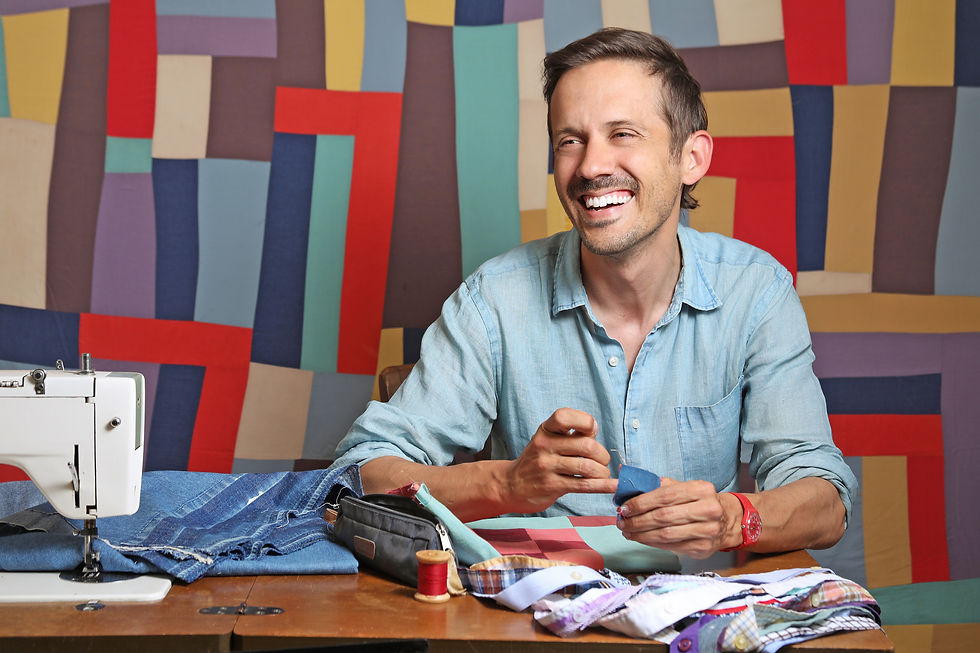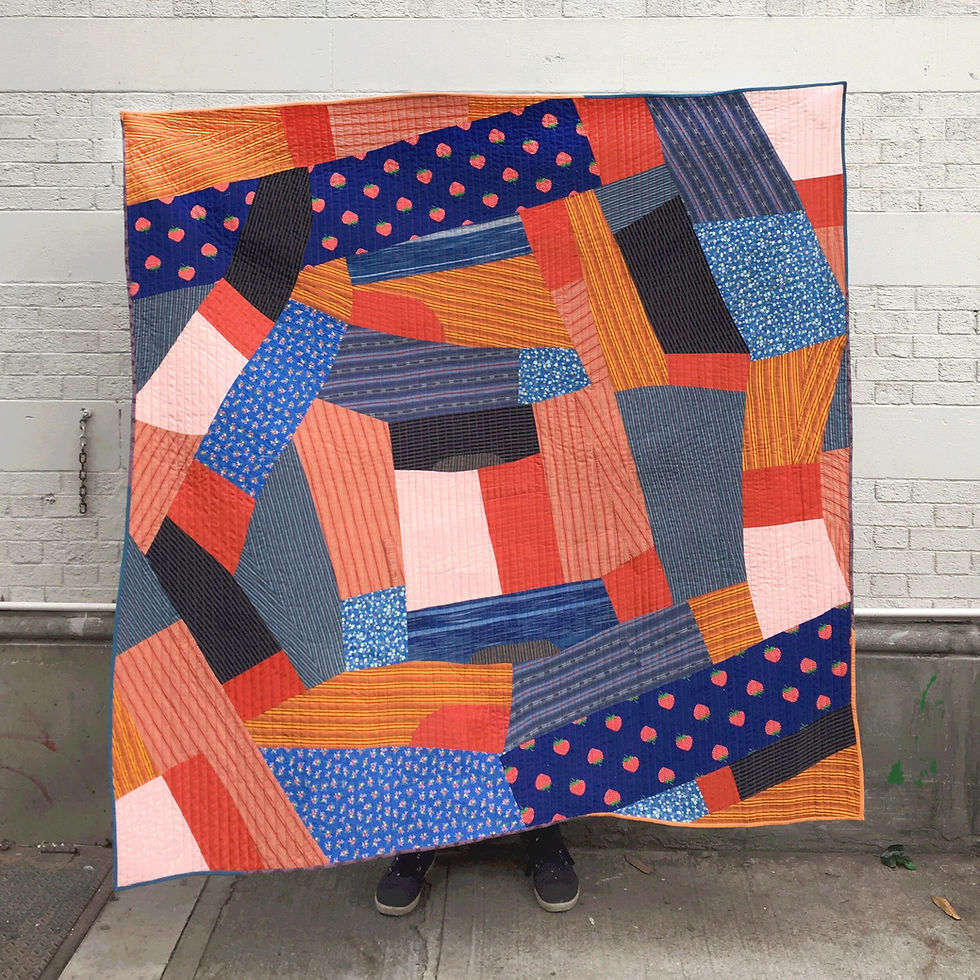Zak Foster: Artist, quilt master, and purveyor of memories
- Ruth Woods

- Mar 27, 2022
- 6 min read
Updated: Mar 30, 2022
Ten years ago, if you'd told Zak Foster he'd be making a living as an artist making quilts he probably wouldn't believe you. Fast Forward to now and the man has amassed a sizeable and dedicated online following of the craft inclined who have found a visual wonderland in his deliciously vibrant projects.
With a podcast on the way and no end to the momentum in site - Zak hopes that the popularisation of this sustainable craft will also cast light on a lesser-known of its functions- that of remembrance. Like every artist, every quilt has its story.
What started your love of quilts?
I was raised in rural North Carolina but never met an actual quilter until I met my partner’s grandma in East Tennessee. I learned how to quilt much like anybody learns anything these days: YouTube and Instagram!
I’ve been quilting for 10-years now and working two jobs the whole time. I taught in public schools for 18-years, and I’ve recently quit that job to become a full-time artist. Feels nice to settle on one job.

What are your philosophies around quilt making ?
My work is largely intuitive and improvisational. I don’t often have a plan when I set out to make a quilt. I just start cutting fabric and see where it leads me.
I have come to see quilts for their transformative properties, quilts have a magic that's uniquely inherent to them - tapping into that magic is what draws me back to the art form over and over.
That magic has its roots in story and history and the life lived in the deconstructed garments I use in so many of my quilts. Knowing the roots of these materials can help us preserve memories, keep stories intact, remember loved ones, and heal us from grieving.
We've heard you've got a new Podcast coming up! What's it about?
Yes! One of the projects I'm most excited about for 2022 is a new podcast, zine project I've been working on called SEAMSIDE. The name is a reference to the backside of a piece of patchwork where you can see how a quilter has assembled all the individual parts to create a new whole.
This is also the side that gets covered up once the quilt is finished, never to be seen again. So in this project, I invite textile artists to sit with me and sew for an hour as we talk about what I call the inner work of cloth, the idea that working with cloth has made us more human.
After each conversation, I offer reflections on what we discussed in the form of a downloadable zine with journaling prompts. I would invite anybody who's interested to check it out. It’s been a really nourishing experience for me, and I’ve met some incredible conversationalists who can shed new light on why making matters.
I see you have also written a zine discussing 12 ways quilting will change your life. Can you enlighten us on a few?
I love 12 Ways Quilting Will Change Your Life! I am certainly not the same person I was when I first started improv-quilting ten years ago, and this zine captures sneak peeks of how this quilting practice has transformed my life and the life of those I know.
My favorite is #10: We go easy
I was so hard on myself when I first started learning how to quilt. Gently over time, improv. quilting has helped me to soften myself into the creative process. It’s given me a safe space to take chances and embrace risks. In doing so it's taught me tricks for doing the same thing in life outside of the studio.
And #1: Cool Kid
When people find out I’m a quilter, they’ve almost always got their own quilt-related story. Usually, it’s about their Grandma or a quilt they grew up with, but regardless, there’s an instant point of connection between us, which is a beautiful way to start a conversation.
Tell us about the memory quilt, and what it means to the people who receive it.
My work over the last few years has centered on memory quilts and more recently, burial quilts. Most folks are familiar with memory quilts, though people may envision t-shirt quilts. My memory quilts are made from significant fabrics entrusted to me by the client, and I use those just like I’d use any other fabric in a quilt.
I see memory quilts as spiritual objects that serve a vital function in the process of grief and healing. All quilts bring comfort, but memory quilts bring the additional layer of soulful comfort. On those days when someone may be feeling a little extra lonesome, they can wrap up in a memory quilt, inhale deeply (often picking up on the singular scent of their loved one who wore the clothes– it’s incredible how long that’ll linger) and feel a little less alone.

When it comes to burial quilts, I usually get a lot of blank stares. Years ago, I remember hearing a story on the radio about a woman who passed away, and in accordance with her last wishes, her friends wrapped her body up in her favorite quilt, put her in the back of a pick-up truck, drove out to the middle of the woods and buried her there. I remember thinking at the time: that’s how I want to go. And I’m sure I’m not alone in that.
It’s my vision to create quilts that are cherished in life, and then when the day comes, this same well-loved quilt can be used in lieu of a casket. Just roll the body in a soft and colorful quilt, and return it to the earth. I’ve been talking with a lot of people in the end-of-life community recently, and they’re very excited about this option for death care: it’s personal, expressive, affordable, natural, and most importantly, death positive.
If it’s one thing we know is going to happen to us, it's death. Let’s be proactive and plan what we can. I already have my own burial quilt designed, and just seeing it sitting folded up in the corner of my bedroom every day not only gives me peace of mind knowing that it’s ready, but it also grounds me in the awareness that our days are so fleeting. Each day is an opportunity to create the world we all want to live in while we can.

How you select your fabrics?
Fabric selection is a team effort between my eyes and my fingers! They each get one vote. A fabric must get both votes to come home with me.
I haven't bought new fabric in years. I remember when I first started quilting I would go to the fabric store and spend these stressful hours trying to pick just the right colors and calculate exactly how much yardage I would need to complete a project. Then I would get home and I would be too stressed to cut into the fabric. I spent so much money on it that I was afraid to mess it up.
When I first started working with repurposed materials, it was really a question of economics in the beginning. Thrift stores and yard sales on the sidewalks of New York City are my favorite places to find fabric. Whenever I'm on a road trip, I always try to plot my rest-stops along the route by finding a good thrift store to stop at.
The more I came to learn about the textile industry, I couldn't stomach the idea that something I loved so dearly was actually causing harm to our one and only home. With that in mind, I committed to working nearly exclusively with repurposed materials. Working with found material has opened up a lot of creative inroads for me that I don't think I would've ever explored if I'd stuck with material cut up the bolt.
When you're working with deconstructed clothing, for example, you end up with all sorts of organic shapes, shapes that have their origin in the curves and contours of our own human bodies. Working with those curves pushes me to try new angles and new orientations in patchwork that I don't think I would have stumbled across if I were still working primarily with the geometrics that we tend to associate with yardage cut off the bolt
Is there anything else you’d like to share with us about your art?

Quilts-as-fashion has been getting some contentious attention lately. I suspect there are a few streams that converge here: one, humanity needs comfort right now. The world is experiencing losses and challenges. That so many of us, collectively want to put on a comfort blanket makes good sense to me.
It also taps into the heightened awareness of sustainability. More and more, creative people are looking for ways to generate less waste, so taking old, tattered quilts and transforming them into fashion is also a part of that consciousness.
And lastly, in a world of mass production, quilts are homemade, sometimes hand-sewn, and often speak to a single maker, usually someone’s mother or grandmother. That means quilts come with a deep well of energy that one just can't buy off the rack.








Comments